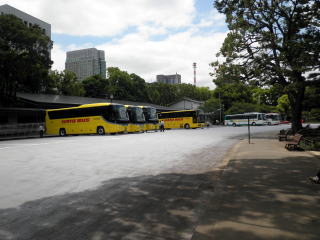This is a statue of KUSUNOKI Masashige,
samurai leader, who died at Minatogawa battle
in 1336 fighting for GODAIGO emperor against
the troops of Ashikaga takauji, the first shogun
of Muromachi government.
We get off at Hibiya station of Hibiya or Chiyada subway line or at Sakurada-mon
station
of Yurakucho subway line, and walk about 5 minutes to the Imperial Palace Plaza from
either of the subway stations.
The Imperial Palace is only open on 23 December, the emperor's birthday,
and 2 January,
new year day for the emperor's family greeting to the public, while the
eastern garden is
open except on Mondays and Fridays.
The Imperial Palace was the Edo castle from which the Tokugawa shoguns
ruled all over
Japan for 264 years until 1867 since 1600 after defeating his rival feudal lords in
Sekigahara battle in 1600. One of great feudal lords, TOKUGAWA Ieyasu started
to
construct his castle and new city in 1590, and named the city Edo taking
decades for
completion. He became the first shogun of the Tokugawas in 1603 and is now enshrined
as the main deity at the Toshogu temple in Nikko together with MINAMOTONO
Yoritomo
and TOYOTOMI Hideyoshi as subdeity.
Meiji emperor and young samurai form the four southwestern feudal clans
overthrew
the Tokugawa's regime in 1867 and moved the capital to Edo from Kyoto in
1869,
renaming Edo Tokyo (eastern Kyoto) and Edo castle Imperial Palace.
Meiji emperor established an morden government, realized the Meiji restoration and
modernized Japan so as to catch up with the level of then European countries
for some
decades. Since then emperors and empresses have lived in the Imperial Palace,
of which
area is 115h. Now the emperor, Akihito and empress Michiko live here, whereas his
princesses and the imperial families live in other palaces one mile away
in the west.



This is another cattle tower Tomoe-Yagura tower.
This is the view of Sakurada-mon gate,
which remains intact. In the Edo period and
the main vassals of the Tokugawa's shoguns
passed the gate to execute their jobs and/or
serve the Shoguns.
On the way to the Plaza we see a big parking
where many sightseeing buses park. Usually
tourists get off bus here and walk to the Plaza.
The principal gate and bridge are seen
beyond the inner moat.
This is a big moat along the Hibiya street.
We walk along the moat some 200 meters first
and turn to the left crossing the moat second.
This is the pain gate to the Imperial Palace,
which faces east. Only the Imperial Palace
in Kyoto have a main gate facing south.
Beyond the bridge Fushimi-Yagura tower
is seen.This is an original tower of the
castle, whcih remains intact.


![]()






